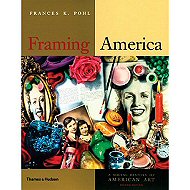|
Framing America
|
|
Frances K. Pohl
|

|

From the preface to the Second Edition
[…] This edition also includes a number of works created since 2001 that address some of the most important aesthetic, technological and political developments of the first decade of the 21st century…
I have incorporated new material throughout the text. For example, there is now a discussion of the religious significance of the grid plans found in both the Aztec city of Tenochtitlan and early Puritan towns, allowing for an interesting cross-cultural comparison […]
In addition to adding new works of art, I have made three major changes in the organization of the text in order to enhance its pedagogical effectiveness. First, and most significant, is the inclusion of illustrated timelines at the beginning of each chapter, which will help the reader navigate the combined chronological and thematic organization of the chapters. Second, the discussion of Henry Ossawa Tanner now appears at the end of Chapter 5 rather than towards the end of Chapter 6, allowing his work to become part of a discussion of the World's Columbia Exposition of 1893, which he attended, and of the American expatriate community in Paris in the late 19th and early 20th centuries. Third, the architecture section in Chapter 8 has been divided into two, with the first half, focusing on Modernist architecture, located after the section on Minimalism and Conceptual art, allowing it to become more firmly situated within the discussion of the art of the 1950s and 1960s.
I have also gone through the entire text, making smaller adjustments to enhance the flow of the narrative, to focus certain broader arguments, or to update or correct factual material. […]
|
|
